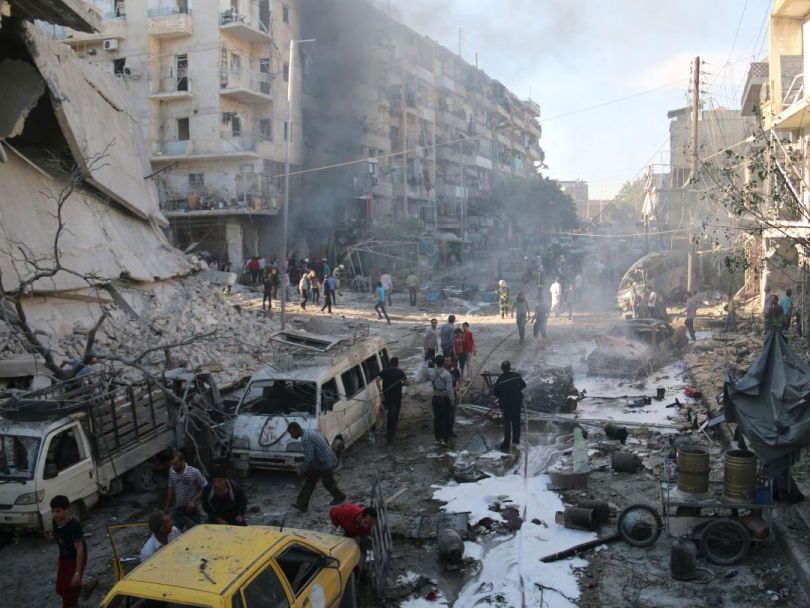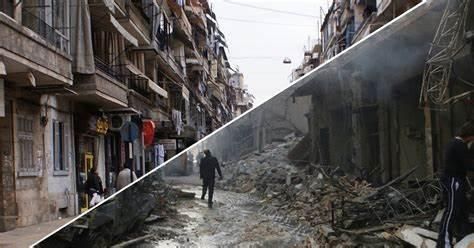By Eric Vandenbroeck and co-workers
How geopolitics reshaped Syria's
trajectory
Believing the war was
won, President Assad shifted focus away from reconciliation and addressing the
needs of his people. Instead, his loyalists collaborated with warlords in
exploiting the masses, worsening the already dire economic situation. This
estranged him from his grassroots supporters. He dissolved supportive militias,
reduced the presence of Iranian and Hezbollah forces, and leaned on Arab
nations for reintegration into the Arab League and the Organization of Islamic
Cooperation (OIC). Russia was not happy with his stubborn behavior and refusal
to meet president Erdogan of Turkey. When militant
groups advanced into Aleppo, fully armed and equipped with drones, supported by
Turkish and U.S. surveillance and GPS, many Syrian army officers were missing
and taken away by Russian forces, lower rank officers
abandoned their positions and instructed their soldiers to lay down their
weapons, return home, and discard their military uniforms, further accelerating
the regime's collapse.
President Erdogan was
equally caught off guard by the rapid decline of the Syrian regime. He fooled
the Russian by speaking of his strategy which was to enable militant groups to
gain access to Aleppo, aiming to pressure President Assad and bring him to the
negotiation table on Turkish term of dividing Syria. However, the situation
took an unexpected turn. Russian forces withdrew from their positions, allowing
militants to advance toward Aleppo, while Erdogan's allies—Israel and the
USA—pursued different plan. They supported and funded mercenaries to push
toward the capital Damascus. Russia denied President Assad any assistance in
the absence of ground troops, reading the situation carefully and did not gives clearance to Tehran to send troops by air since US
threatened Iraq government not to allow passage of troops to support According
to reliable sources Assad removed at a gun point and he is under house arrest
in Russia. The Russian security guards at the President`s Palace did not allow
President Assad to address his army or his own people and instead forcefully
removed him from the palace, at a gun point, without any prior notice even his
son Hafiz was not aware nor his brother Maher, not to speak of even his own
security guards. He was transferred to Khmeimim
Russian air base in Latakia city before deporting him to Moscow with his son
who joined him later and close aids and put him allegedly under house arrest.
Arab and Islamic Spring - Turkey's Role
At the time of the
onset of the Arab Spring in Tunisia in 2011, thousands of miles away, Turkey
was already preparing for a significant geopolitical shift. Months before the
waves of regime changes reached Damascus, Turkish authorities were busy
building tent camps near the Syrian border. Ostensibly, these camps were
designed to shelter refugees fleeing conflict, but in retrospect, they signaled
a calculated strategy to reshape the Syrian regime. The goal appeared to be the
toppling of the Syrian government and its replacement with a so-called
"moderate Islamic" administration—moderate in public rhetoric but
harboring covert, extremist tendencies.
Turkey's ambitions in Syria were deeply rooted in both
ideology and regional strategy. The ruling Justice and Development Party (AKP),
led by Recep Tayyip Erdogan, envisioned a Neo-Ottoman influence extending
across the Levant. By aligning with Islamist groups and capitalizing on the
chaos of the Arab Spring, Ankara sought to position itself as a central player
in the transformation of the Middle East.

The Syrian Conflict: A Proxy for Regional Ambitions
Fourteen years later,
Syria stands as a testament to the devastating consequences of foreign
interference and regional power struggles. Factories in Turkey reportedly
produced over half a million new Syrian flags, symbolizing the envisioned state
under Turkish influence. In major Syrian cities like Damascus and Aleppo, the
Turkish flag was raised, signaling a stark shift in sovereignty and heralding a
new era under Erdogan's leadership.
This transformation
was not achieved through conventional diplomacy or soft power alone. It
involved a complex web of alliances with militant factions, including extremist
groups. The current Turkish foreign minister, Hakan Fidan, played a pivotal
role in this strategy. A close confidant of Erdogan and a former head of
Turkey's National Intelligence Organization (MIT), Fidan became a central
figure in Turkey's clandestine operations in Syria.
From Afghanistan to Syria: Parallels of Proxy Wars
The patterns of
foreign intervention in Syria mirror those in Afghanistan, where decades of
conflict transformed the nation into a proxy battleground for competing global
and regional powers. In Afghanistan, the Soviet invasion of 1979 sparked a
U.S.-backed resistance movement that ultimately gave rise to the Taliban.
Similarly, the Syrian war saw external powers funding and arming militant
groups, some of which evolved into extremist factions like ISIS and Hay'at Tahrir al-Sham (HTS). There was a tendency to
replicate the Taliban's approach in Syria, promoting extremism and
fundamentalism under a reinterpreted concept of Islam, which was often imposed
through force.
Both conflicts reveal
a troubling trend: external powers exploiting domestic instability to advance
their geopolitical ambitions. In Afghanistan, the U.S. and its allies justified
prolonged military intervention under the pretext of combating terrorism and
promoting democracy. In Syria, fostering regime change served as a cover for
foreign agendas.
The Jolani Connection and the Symbolism of Qasioun
One particularly
symbolic moment encapsulates Turkey's ascendancy in Syria: Hakan Fidan,
alongside Abu Mohammed al-Jolani, the leader of HTS, was reportedly seen
sipping tea on Mount Qasioun, overlooking Damascus.
This imagery carries profound significance. Mount Qasioun,
a historic vantage point over the Syrian capital, is not just a physical
location but a symbolic marker of sovereignty. By asserting their presence
there, Turkey and its allies sent a clear message about their intentions to
reshape Syria's political landscape.
This act also drew a direct connection to the Umayyad
Dynasty, which had its capital in Damascus. Erdogan's neo-Ottoman vision is
steeped in such historical references, positioning Turkey as the inheritor of
Islamic leadership and regional dominance. The imagery of Qasioun
was thus a calculated move to evoke the glory of past empires while asserting
contemporary influence.

The Cost of Ambition
However, this
ambitious project has come at a staggering cost. Syria has been devastated by
years of war, with hundreds of thousands killed and millions displaced. The
country's infrastructure lies in ruins, and the social fabric has been torn
apart. Syria has, in many ways, been handed over to "terrorist-designated
groups", who act as proxies for vested-interest nations. These groups
serve the geopolitical agendas of those seeking military intervention under the
guise of protecting minorities.
This mirrors similar
interventions in former Yugoslavia and Rwanda, where the principle of
"Responsibility to Protect" (R2P) was invoked. In Syria, it is likely
that calls for protection could escalate if sectarian violence and the
targeting of minorities by mercenaries increase. However, such rhetoric often
serves as a pretext for advancing external powers' interests. Otherwise, there
is no explanation for turning "New Syria" into a pilgrimage site for
foreign dignitaries to pay respect to leadership groups considered terrorists
under United Nations Security Council Resolutions.
The Humanitarian Crisis and Displacement
The toll on civilians
in both Afghanistan and Syria is staggering. Millions of people have been
displaced internally and externally, creating one of the largest refugee crises
in modern history. The destruction of infrastructure, loss of livelihoods, and
erosion of cultural heritage have left indelible scars on both nations.
Ankara now faces
growing concerns about the long-term fallout of the Syrian conflict,
particularly as the USA and Israel collaborated to topple the Syrian regime and
support the establishment of an independent Kurdish enclave in Syria. This
development poses significant threats to Turkey's security and sovereignty,
with potentially dangerous consequences for the region when the conflict
between Tel Aviv escalate on who will grasp more
territories of Syria. The Kurdish dreams of establishing an independent enclave
in Syria will not materialize for now in spite of the
international pressure on Turkey not to let the Syrian forces take on them and
instead reconcile and gives the Kurds more autonomy. Ankara is adamant and will
not allow this to happen but will taste its own poison in years to come.
Conclusion
The trends in the
Middle East—such as military and intelligence cooperation, realignment of
alliances, and sectarian rivalries—support the claim that Israel, Turkey, and
Azerbaijan may align to counter Iran. This collaboration aligns with their
shared interests and the broader strategy of external powers to weaken Iran's
influence.
From Afghanistan to
"Suyriastan," the patterns of intervention,
proxy wars, and ideological ambitions reveal a troubling trend. The Arab
Spring's promise of democratic transformation was quickly overshadowed by
competing interests. Turkey's Neo-Ottoman vision has left a profound imprint on
Syria's trajectory, raising questions about sovereignty and stability in the
Middle East. There is a strong consensus among Arab capitals not to allow an
Islamic State in Syria. Egypt will be the next target for Israel and US to
seize Suez Canal and Jordan to follow as an alternative homeland for
Palestinians who will be expelled from Gaza and West Bank as well.
A significant aim of
deploying large numbers of trained and brainwashed Islamists was to target and
kill minorities in Syria, as well as to infiltrate communities of moderate
Islamic faith followers whose beliefs did not align with their medieval ideologies.
Their ultimate goal is to establish an Islamic state
of their own understanding of Islam, in Syria, as a base to further their
broader agenda, stretching from Mauritania in West Africa to the northwestern
region of Xinjiang in China to cause inter fighting, chaos and instabilities
rather than serving the cause.
The legacies of Afghanistan and Syria serve as
cautionary tales about the dangers of foreign interference and the exploitation
of vulnerable nations. As the dust settles on over a decade of conflict, the
enduring impact on the lives of millions will remain a stark reminder of the
human cost of geopolitical ambition.
For updates click hompage here